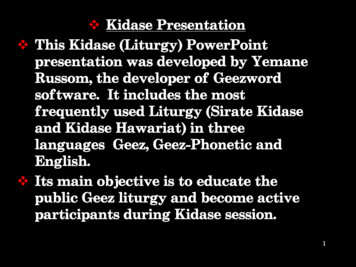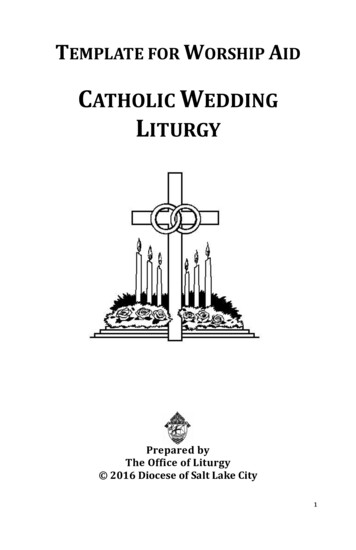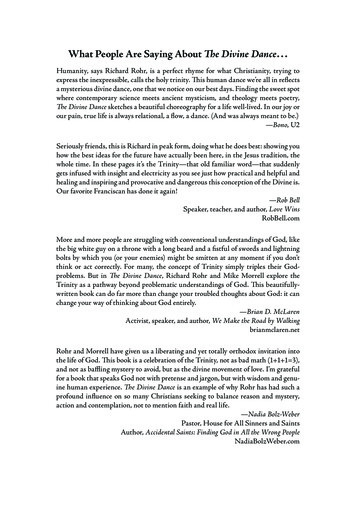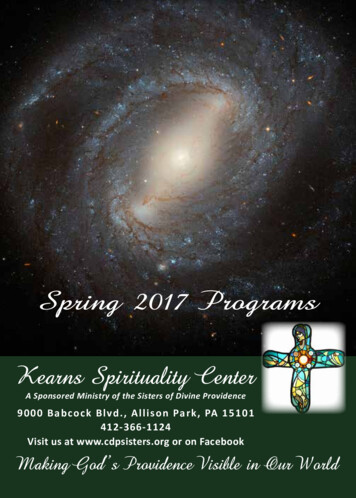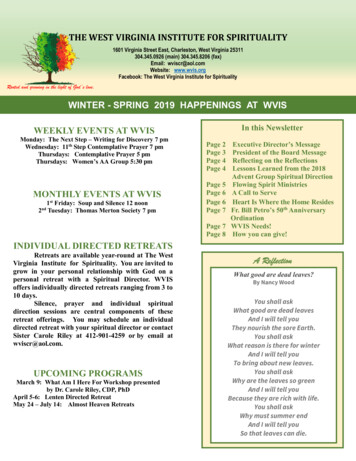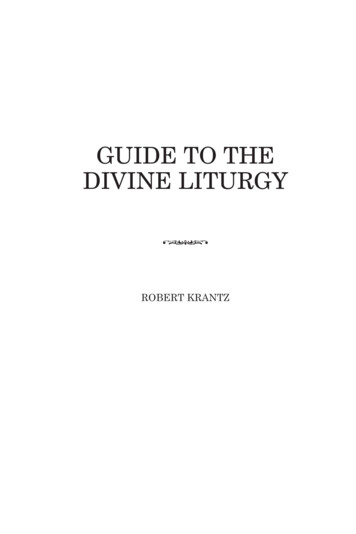
Transcription
GUIDE TO THEDIVINE LITURGYoROBERT KRANTZ
Copyright 2011 by Ellinas Multimedia, Incorporated.All rights reserved.Ellinas Multimedia9570 Research DriveIrvine, CA 92619www.ellinasmultimedia.com800-410-8388Cover design by: theBookDesignersCover photography and additional photographs: Carrie ComanBook design by: Judy Seling, Seling Design LLCPhotographs: Carrie ComanFor Chris, Nicholas, and George –No thought could I share with you, no lesson could I teachto you, no gift could I give to you greater than taking yourhands and guiding them to Christ’s hands. For in His handsyou will be guided safely through your journey in life.For Tricia, so happy am I that God called us to dance theDance of Isaiah together.And for Mom words can’t express my gratitude andlove.
Acknowledgments:Thank you to all the priests who have guided me andcounseled me in the making of this book. In particular,Father Steven Tsichlis and his son, Chris, whosepassion and knowledge for the Divine Liturgy areunmatched.
IntroductionI was born into and raised in the Orthodox Faith (thename Krantz was shortened from Karountzos by mygrandparents). Growing up, I attended our GreekOrthodox Church in Milwaukee, Wisconsin. Back then,nearly everything during the Liturgy was spoken inGreek (including the sermon!). I remember alwayspestering my mother, asking her what the priest wassaying. As the years went by, I grew to love the feelingthat attending the Liturgy gave me. I knew all thesongs the choir sang in Greek; I loved the incense,icons, and candles. I always felt a great sense ofcommunity and family when I was at church.But, as I learned later in life, there was one slightproblem: I didn’t understand very much at all aboutthe Divine Liturgy.It was almost like the Divine Liturgy was awonderful foreign film that I watched over and overagain. The images I saw, the music I heard, and theemotion I felt led me to love it, but I really didn’tunderstand it. The booklets in the pews allowed meto “follow along,” but they never explained what wasreally happening during the Divine Liturgy.I went along like this for a long time. That wasuntil an event occurred in my life that changed all ofthat: my wife and I had children. I knew that I was1
23responsible for their spiritual life, and I wasn’t aboutto mess that up. However, as they grew up, I’d watchthem as they sat next to us in church, and I could seeit was hard for them to stay focused on the liturgybecause they had no idea what was going on. I knew Ihad to teach them. But how could I teach them aboutsomething that I knew so little about? So, elevenyears ago, my wife and I began attending our church’s“Orthodoxy #101” class. I realized very quickly thatI knew virtually nothing about our faith and inparticular The Divine Liturgy.Since then, I have learned as much as I could aboutthe Divine Liturgy, not only for myself and my family,but also in hope that it may help others out there whoare “liturgically challenged.”My biggest fear when I started out in learningabout the Divine Liturgy was that it would beoutdated and not relevant for our times. What I foundto be true was the exact opposite; it is a masterpiece.The Divine Liturgy is brilliantly thought out anddivinely composed.What the Orthodox faith has done is answer onecentral question of faith brilliantly. The question is:how shall we worship God? The Orthodox answer issimple: we will worship Him on earth just as he isworshipped in Heaven. Simple, but brilliant, isn’t it?To support that central theme, the Orthodoxfaith has composed the liturgy by weaving togethera religious mosaic of biblical verses (yes, there is alot of the Bible in the Liturgy), firsthand accounts(yes, eyewitnesses have seen how God is worshippedin Heaven!), and tradition (tradition meaning, forexample, that our faith is practiced the way theApostles worshiped Christ and we’ve never brokenfrom that tradition), and much more, including aheavy dose of common sense (i.e., at the Last Supper,when Jesus said, “Do this in remembrance of me ,”it’s a pretty good bet that He meant we should “Dothis” [celebrate the Liturgy and take communion]!)As I hope you will see, it is so brilliantly thoughtout, so divinely inspired that you can’t help but feelthat when you are in the Orthodox faith, you are rightwhere God wants you to be.May I also say that this is by no means atheological dissertation or scholarly essay on TheDivine Liturgy. There are authors far smarter thanmyself who have written books for that. What I’veattempted to do in these pages is make the DivineLiturgy understandable to the mother and father whowant not only their faith renewed but also assurancethat their child’s faith is never lost. It’s written for thegrandparents who want to understand the service forthemselves, their children, and grandchildren. It is forthose wonderful, inspiring people who are thinkingof converting or who have converted to the Orthodoxfaith. It’s for those who’ve always been in the faith, forthose new to the faith, and for those thinking to jointhe faith.Lastly, I see this not as a definitive work but,rather, as an ongoing work – Guide to The DivineLiturgy 1.0, if you will. I hope that you will e-mail meyour notes, complaints, corrections, insights, likes, anddislikes to sales@ellinasmultimedia.com so that, astime goes on, together we can make this book betterand better for generations to enjoy so they can getthe most possible out of the Divine Liturgy and thewonderful faith of Orthodoxy.In His name,Robert KrantzEllinas Multimedia
GUIDE TO THEDIVINE LITURGYo
6Vesting of ClergyIn the Orthodox faith, the priest does not simply showup and toss on his robe and other garments. First,he prepares by reciting special prayers outside theIconostasion (Altar Screen) before the Royal Doors.He kisses the Holy Icons of the Iconostasion, and thenenters the Sanctuary through the North Door saying:“I shall enter into Your dwelling place; beforeYour holy temple I will bow in fear of You.”As with so much of the Divine Liturgy, the priest’suse of vestments has Biblical underpinnings. Havingentered the Sanctuary, the priest wears his vestments.The purpose of vestments were “for glory and forbeauty” (Ex 28:2 & 40), to enable the leaders for“ministering in the holy place” (Ex 35:19, 39:1, 41),“that they may serve Me as priests” (Ex 28:4, 41).The way in which the vestments are decoratedcomes from the Old Testament, where the garmentswere decorated and made of beautifully colored“fine linen skillfully worked” and embroidered withneedlework (Ex 28:6, 36, 39), with bells of gold (Ex28:33), and with a plate of gold engraved “Holy is theLord” (Ex 28:36).There are five vestments that the priest recites aspecial prayer for:1. EPIMANIKA (cuffs):The Epimanika are cuffsworn by the deacon andhigher ranks of clergy. Thedeacon wears them under theSticharion. They representstrength, patience, andgoodwill. The cords which tie them represent the ropewith which the hands of our Lord were bound.(Wearing first Epimanika – right cuff)7“Your right hand, Lord, is made glorious inmight; Your right hand, Lord, has crushed theenemies; and in the fullness of Your glory, Youhave routed the adversary.” (Exodus Chapter 15,Verses 6-7)(Wearing second Epimanika – left cuff)“Your hands have made me and fashioned me:give me understanding and I shall learn Yourcommandments.” (Psalm 119, Verse 73)2. STICHARION:This is a long, full-sleevedtunic that reaches the ankles.This is the original baptismalrobe of the newly baptized.It is symbolic of a pure andtranquil conscience, a spotlesslife, and spiritual joy in theLord. It states Christ’s purityand illumination as well as thepurity and brightness of theHoly Angels. It is also worn asthe outer garment by acolytes. It usually has a crossembroidered or applied to the center of the back,between the shoulder blades.“My soul rejoices in the Lord, for He has clothedme with a robe of salvation and covered me witha garment of happiness; as a bridegroom He hascrowned me, and as a bride He has adorned mewith gems.” ;
893. EPITRACHELION:5. PHELONION:The Epitrachelion (stole: meaning“on the neck”) is a long narrowband of vestment material thatfits around the priest’s neck atthe center, is joined at the neckby hooks, and hangs down belowthe priest’s knees. It is symbolicof priestly dignity and power andmust be worn by the priest at allliturgical services. It also symbolizes the Cross carriedby our Lord upon His shoulders. A church servicecannot be celebrated without it. The tassels that hangat the lower part of the stole represent the souls of theparishioners that hang on the Spiritual Father’s neck.The Phelonion is a cape-like outervestment, long in back and short infront, with an opening for the head topass through. It signifies the crimsonRobe, with which the soldier clothedour Lord Jesus to mock Him while hewas in the Praetorium.Blessed is God who pours out grace upon Hispriests: as oil upon the head, which ran downunto the beard, the beard of Aaron, even to thehem of his garment, at all times, now and alwaysand forever and ever. Amen. (Psalm 133, Verse 2)The priest blesses each garment with the sign of the cross4. ZONI (belt):The Zoni is worn over the Sticharion and Epitrachelionand is used to hold up the Sticharion that representswisdom and strength.“Blessed is God who girds me with strength andmakes my way blameless and strengthens my feetlike the hart’s, at all times, now and always andforever and ever. Amen.” (Psalm 133, Verse 2)“Your priests, O Lord, shall clothethemselves with righteousness,and Your saints shall rejoice injoy, at all times, now and alwaysand forever and ever. Amen.”(Psalm 132, Verse 9)and kisses them. He then washes his hands to signify hispurity, reciting:“I will wash my hands in innocence, and goaround Your altar, O Lord.” (Psalm 26, Verse 6)PREPARATION OF THE EUCHARISTICGIFTSOver an hour before the parishioners arrive and beginthe Divine Liturgy Service, the priest arrives at thechurch and begins preparing for the celebration of theDivine Liturgy. The service of preparation (in Greekcalled the proskomidi or prothesis) is the liturgicalcelebration that surrounds the preparation of thebread and wine for its use in the Divine Liturgy.Originating in the eighth century, the service inits present form probably dates from the fourteenthcentury. Originally performed by deacons, todaythe service is normally done by a priest who may beassisted by a deacon during the Orthros or Service of
1011Morning Prayer that precedes the Liturgy. In additionto the preparation of the bread and wine for use atthe Eucharist, the Proskomede is also a service ofremembrance and intercession: many of the saints arecommemorated, ranging from the prophets of the OldTestament to the apostles, from bishops to martyrs,from monks and nuns to miracle-workers; and prayersof intercession are offered for those members ofthe local congregation and others who are sick andsuffering, as well as for those Christians who “havedied in hope of resurrection to eternal life,” as theprayer says.After vesting and washing his hands, the priestproceeds to the table of oblation, which stands to theleft of the Holy Altar. While preparing the necessaryvessels – the paten (diskos), the chalice (poterion), thestar (asterisk), the lance (longhi), the spoon (lavis), theveils (kalimmata) and the flasks of wine and water –the priest says:Then the priest takes the bread of offering (profora) inhis left hand and the lance in his right; and raising theloaf, he makes the sign of the cross over it three timeswith the lance and says:BETHLEHEM, be prepared! Eden is open toall! Ephratha be radiant! For in the cave, thewood of life has blossomed forth from the Virgin,whose womb has symbolically appeared asparadise. And we who eat of this divine seedlingshall live and not die as did Adam. For Christshall live and not die as did Adam. For Christ isborn to resurrect the icon, which has fallen.You have redeemed us from the curse of thelaw (GAL 3:13) by Your precious blood. Beingnailed on the cross and pierced by a lance, Youhave bestowed immortality upon humanity. OurSavior, glory to You!Blessed is our God now and ever and unto theages of ages. Amen.In remembrance of our Lord, God and SaviorJesus Christ.He then thrusts the lance into the center of the loafon the right side of that part of the seal that bears theletters IC XC NIKA, saying:Like a sheep, he was led to the slaughter (Isaiah53:7)Then he cuts the left side and says:As a spotless lamb silent before its shearers, hedid not open his mouth (Isaiah 53:7)And cutting into the upper side:In his humiliation, justice was denied him (Acts8:33)Finally, cutting along the lower side:Who shall declare his generation? (Isaiah 53:8)Removing the square particle known as the Lamb fromthe loaf, he says:For his life was taken away from the earth (Acts8:33)Laying the bread on the paten with the seal facingdownward, the priest cuts the sign of the cross into thebread, saying:The lamb of God who takes away the sins of theworld is sacrificed for the life and salvation ofthe world (John 1:29)By your crucifixion, O Christ, the tyranny of theAdversary was brought to an end. The powerof the enemy was crushed. Neither an angelnor a man has saved us, but, rather, the LordHimself. Glory to You!
1213And he turns the Lamb over, with the seal facing upand pierces the upper right side with the lance, saying:3. Of the holy, glorious and all-praised apostlesPeter and Paul, of the Twelve and the Seventyand of all the holy apostles.One of the soldiers pierced his side with a lance.And at once came forth blood and water: and hewho saw it bore witness and his witness is true(John 19:34-35)Emptying the flasks of wine and water into the chalice,the priest says:Blessed is the union of Your Holy things nowAnd always and unto the ages of ages. Amen.Then, cutting out the triangular particle bearing theletters MΘ (Mother of God), the priest says:In honor and memory of our most blessedlady, the Mother of God and ever-virgin Mary,through whose prayers, O Lord, accept thissacrifice upon Your altar in Heaven.Placing the particle on the paten, to the right of theLamb, he says:At Your right stood the Queen, clothed in anembroidered mantle of gold and many colors(Psalm 44:10)Cutting smaller triangular-shaped particles for thenine orders of angels and saints and placing themon the paten to the left of the Lamb, he begins thecommemorations:1. In honor and memory of the ArchangelsMichael, Gabriel, Raphael, and all the heavenlybodiless powers.2. Of the honorable, glorious prophet andforerunner John the Baptist: of the holy andglorious prophets Moses, Aaron, Elijah, Elisha,David, and Jesse: of the holy three children,Daniel the prophet, and of all the holy prophets.4. Of the holy fathers and great ecumenicalteachers and bishops Basil the Great, Gregorythe Theologian, and John Chrysostom;Athanasios and Cyril, John the Merciful,patriarchs of Alexandria; Nicholas of Myra andSpyridon, the wonderworkers, and of all holybishops.5. Of the holy first martyr and archdeaconStephen; of the holy and great martyrsDemetrios, George, Theodore the Recruit andTheodore of Tyre; of the holy martyrs Thecla,Barbara, Kyriake, Euphemia, Paraskeve,Katherine, and all of the holy martyrs.6. Of our holy and God bearing (monastic)fathers Anthony the Great, Euthymios,Savvas, Onuphrios, Peter and Athansios ofAthos, Christodoulos of Patmos, and Sergios ofRadonetz; of our venerable (monastic) mothersin God Pelagia, Theodosia, Anastasia, Eupraxia,Theodulia, Euphrosyne, Mary of Egypt, and ofall holy ascetics.7. Of the holy and glorious wonderworkers andhealers who worked without payment Kosmasand Damian, Cyrus and John, Pateleimon andHermolaos, and of all the holy healers wholabored without accepting payment.8. Of the Holy and righteous ancestors of GodJoachim and Anna, Joseph the betrothed: ofSaints(s) whose memory wecelebrate today and of all Your Saints.
149. Of our holy Father John Chrysostom,Archbishop of Constantinople, whose holyLiturgy we are celebrating (or: of our holy fatherBasil the Great, Archbishop of Caesarea). Saintof God, pray for us.Then the priest cuts small pieces for the living andthen for the departed and places them on the paten infront of the Lamb:Remember, O Loving Master, all OrthodoxBishops: our Patriarch , our Archbishop, our Bishop the honorablepresbyters, the deacons in the service of Christ,and those in holy monastic orders.Remember, O Lord, our co-celebrants,presbyters, deacons, and all our brothers, whomin the depths of your compassion have beencalled to communion with You, our all-goodMaster.Then he commemorates by name those of the livingwhom he will, beginning with the bishop who ordainedhim, if still alive:Remember Your servants and forgivethem their sins and transgressions.Then he commemorates by name those of the deadwhom he will, beginning with the bishop who ordainedhim if no longer alive:Remember Your servants who have fallenasleep and grant them forgiveness of sins.Remember the founders of this holy Churchand all of our departed Orthodox fathers andbrothers, mothers and sisters, who in thehope of resurrection to life eternal may havecommunion with You . and forgive them alltheir sins and transgressions.15And finally he prays for himself:Remember, Lord, my unworthiness and forgivemy voluntary and involuntary transgressions.Then, blessing the censer, the priest recites the prayerfor the offering of incense:We offer You incense, Christ our God, as asweet smell of spiritual fragrance: receive it onYour altar in heaven and send down upon us inreturn the grace of Your all-holy Spirit.And having censed the star, and placing it over thepaten, the priest says:And the star came and stood over the placewhere the Child was (Matthew 2:9)The Priest censes the small veil for the paten whilereciting verses from Psalm 92:The Lord is king: He is robed with splendor: theLord is clothed with power; He wearst it like abelt. For He has established the world so that itcannot be moved. (Psalm 92: 1-2)The priest censes the second of the small veils, this onefor the chalice, in the same way as the first. He placesit over the chalice, saying:Your glory has covered the heavens, O Christ,and the earth is filled with Your praises.(Habakkuk 3:3)Having censed the final veil, (called “aer”), the priestplaces it over the paten and chalice, saying:Cover us over with the cover of Your wings;drive away from us every alien and enemy;make our lives peaceful. Lord, have mercy on usand upon Your world and save our souls, O GoodOne who loves mankind.
16Then the priest censes the offering, saying:Blessed is our God, who is thus well-pleased.Glory to you at all times, now and ever and untothe ages of ages. Amen.For these precious gifts that are offered, let uspray to the Lord. O God, our God, who has sentthe heavenly bread, our Lord, God and SaviorJesus Christ, as the food of the whole worldand as our redeemer and benefactor, to blessand sanctify us. Bless this offering and acceptit on Your altar in heaven. In Your goodnessand compassion, remember both those whohave offered it and those for whom it has beenoffered; preserve us so that we might celebrateYour holy mysteries uncondemned. For holy andglorious is Your honorable and majestic name, ofthe Father and of the Son and of the Holy Spirit,now and ever and unto the ages of ages. Amen.The priest bows, kisses the offering, and says:Holy is God, the Father without beginning;holy and strong the Son, who is also withoutbeginning; holy and immortal, the all-HolySpirit; Holy Trinity, glory to You. Glory to You,Christ and God and our hope, glory to You. MayChrist, our true God who, born in a cave andlaid in a manger for our salvation, through theprayers of his most holy Mother; of the gloriousprophet and forerunner John the Baptist;of Saint(s) whose memory we celebratetoday; of our fathers among the Saints JohnChrysostom, Archbishop of Constantinople (or:Basil the Great, Archbishop of Caesarea) and ofall Your saints, have mercy upon us and saveus, for He is good and loves humility. Throughthe prayers of our holy fathers, Lord JesusChrist our God, have mercy on us and save us.17The Priest censes the offering and altar, saying:Being God, You were present in the tomb byYour body and yet in Hades by Your soul, inParadise with the thief, and on the throne OChrist, with the Father and the Holy Spirit,filling all things but encompassed by none.Then Psalm 50 (51)After having incensed the sanctuary, the icons,the choir, and the people, the priest returnsto the sanctuary, and again incenses the holytable. He then places the censer in its properplace, and goes to join the other priest Standingtogether before the holy altar, they make threebows, each praying silently and saying:Heavenly king, comforter, spirit of truth, Whoare everywhere present and fill all things,treasury of blessings and giver of life, come anddwell within us, cleanse us of all stain, and saveour souls, O gracious Lord.Glory be to God in the highest, and on earthpeace, goodwill among men. (Twice.) (Luke 2:14)O Lord, You will open my lips, and my mouthwill declare Your praise. (Psalm 51:15)The priest then kisses the holy gospel book, thedeacon the holy table.After which the deacon bows his head to thepriest, and holding the orarion with threefingers of his right hand, he says:It is time for the Lord to act.(Psalm 119:126)Master, give the blessing.The Divine Liturgy of St. John Chrysostom isabout to begin!
18The First Sentence of the Divine Liturgy.“Blessed is the kingdom of the Father and theSon and the Holy Spirit, now and forever and tothe ages of ages.”This first sentence of the Divine Liturgy is a boldstatement of faith. Everything we say after this isprayers we ask of God, but this opening statement isa proclamation of faith in God. We are stating to Godthat we believe in the beauty of Heaven, we believe inthe Father, Son, and Holy Spirit, and we believe theyare for eternity. We as a congregation are at the frontdoor of Heaven, seeking entrance. God, hearing us,opens the door and the connection between Heavenand earth begins.Another way to look at this is how, oftentimes whena plane is about to take off, the pilot will announcethe destination of the plane so that everyone onboard is reminded of where he or she is headed. Theopening statement of the Divine Liturgy is somewhatsimilar. The middle part of the church is called theNave. In Latin the translation of that word is Ship. So,in essence, the parishioners are seated in the “ship.”But, where are they headed? The priest lets all the“passengers” know; to the Kingdom of the Father, Son,and Holy Spirit, which is Heaven. In fact, all sacramentsbegin with the words “Blessed is the kingdom ofthe Father and the Son and the Holy Spirit, now andforever and to the ages of ages.”With these words, our communion with Heaven hasbegun.19THE DIVINE LITURGYOF SAINT JOHN CHRYSOSTOM(Liturgy of the Word – also called Liturgyof the Catechumens)Priest: Blessed is the kingdom (Mark11:10)of the Father and the Son and the Holy Spirit,now and forever and to the ages of ages (cfJude 1:25, Ephesians 3:21).People: Amen.THE GREAT LITANYDeacon: In peace let us pray to the ----------------Η ΘΕΙΑ ΛΕΙΤΟΥΡΓΙΑ ΤΟΥ ΑΓΙΟΥΙΩΑΝΝΟΥ ΤΟΥ ΧΡΥΣΟΣΤΟΜΟΥἹερεύς: Εὐλογημένη ἡ βασιλεία τοῦ Πατρὸς καὶτοῦ Υἱοῦ καὶ τοῦ Ἁγίου Πνεύματος, νῦν καὶ ἀεὶκαὶ εἰς τοὺς αἰῶνας τῶν αἰώνων.Λαός: Ἀμήν.Διάκονος: Ἐν εἰρήνῃ τοῦ Κυρίου δεηθῶμεν.
20The Great Litany“Come to me, all you that labor, and are heavyladen, and I will give you rest. Take my yokeupon you, and learn from me: for I am meekand lowly in heart; and you shall find rest toyour souls. For my yoke is easy, and my burdenis light.” (Matthew 11:28:30)When we read the verse from the Bible above, itreminds us that this is the beautiful God who awaits usand listens to us as we begin our “litany’”of prayers.Whatever your burden, whatever your sin, whateveryour problem, whatever your troubles, here stands ourGod ready to listen and help us. So many parishionersfeel they have “labored;” they feel “heavy laden” andare looking for “rest for their souls.” Our loving andcompassionate God is happy to see us and right fromthe beginning of the Divine Liturgy He is in essencesaying to us, “take all your problems and put them onMe and I will give you rest.” In fact, when you read theprayers of the Great Litany, you’ll notice a word thatkeeps reoccurring; peace. “In peace, let us pray ,”“For heavenly peace ,” “For peace in the wholeworld ,” “ for peaceful times.” In fact the wordspeace or peaceful appear dozens of times in the DivineLiturgy. That is not a coincidence! It seems like the Lordand the church fathers were trying to tell us something.They are aware that when people come to church,more often than not they have many problems ontheir minds. They know parishioners are worried abouttheir children, their finances, someone who may be ill,someone who may be traveling, their career, and so on.The church fathers must have understood this becauseso many of the prayers we are making to God involvethe word peace. One of the beauties of God21People: Lord, have mercy.Priest: For the peace of God (Philippians 4:7)and the salvation of our souls, let us pray tothe Lord.People: Lord, have mercy.Deacon: For peace in the whole world (cf.Zechariah 1:11), for the stability of the holychurches of God, and for the unity of all, let uspray to the Lord.Λαός: Κύριε ἐλέησον.Διάκονος: Ὑπὲρ τῆς ἄνωθεν εἰρήνης καὶτῆς σωτηρίας τῶν ψυχῶν ἡμῶν, τοῦ Κυρίουδεηθῶμεν.Λαός: Κύριε ἐλέησον.Διάκονος: Ὑπὲρ τῆς εἰρήνης τοῦ σύμπαντοςκόσμου, εὐσταθείας τῶν ἁγίων τοῦ ΘεοῦἘκκλησιῶν καὶ τῆς τῶν πάντων ἑνώσεως, τοῦΚυρίου δεηθῶμεν.
2223People: Lord, have mercy.is that He doesn’t respond to our requests for peace bysaying, “Okay, I’ll think about it.” Or “Let me mull thatover.” As we are making this litany of requests, He isimmediately granting it to us.How do we know this? He told us in Matthew 18:1920, which says: “I say to you that if two of you agreeon earth concerning anything that they ask, it will bedone for them by my Father in Heaven. For where twoor three are gathered together in My Name, I am therein their midst.” And we, the “People” confirm backto God that we know He is granting our requests bysaying, “Lord, have mercy.” Many think that the wordsLord have mercy are being used like words from an oldmovie where a prisoner who has been locked up forweeks has a light shone upon him by the warden, andthe prisoner yells out, “Have mercy on me!” only tohave the warden slam the door shut again. That is nothow the Orthodox faithful understand the words Lordhave mercy. In fact, the Orthodox understanding, as wewill describe shortly, is a more comforting and soothingunderstanding of those words.Also, did you ever notice that, when you walk intochurch with all your problems on your mind, moreoften than not when you leave Church things seembetter more peaceful? This Great Litany is wherethat transformation begins. In fact, The Great Litanyis sometimes referred to as “The Litany of Peace.”As the Great Litany comes to an end, there is oneother interesting point to notice; in many of the GreatLitany prayers, we are praying for someone otherthan ourselves. We are praying for our President, ourchurches, our country, our Archbishop, for those whoDeacon: For this holy house and for those whoenter it with faith, reverence, and the fear ofGod, let us pray to the Lord.People: Lord, have mercy.Deacon: For our Archbishop (Name), thehonorable presbyters, the deacons in theservice of Christ, for all the clergy and laity, letus pray to the Lord.People: Lord, have mercy.Λαός: Κύριε ἐλέησον.Διάκονος: Ὑπὲρ τοῦ ἁγίου οἴκου τούτου καὶτῶν μετὰ πίστεως, εὐλαβείας καὶ φόβου Θεοῦεἰσιόντων ἐν αὐτῷ, τοῦ Κυρίου δεηθῶμεν.Λαός: Κύριε ἐλέησον.Διάκονος: Ὑπὲρ τοῦ Ἀρχιεπισκόπου ἡμῶν(Ὄνομα), τοῦ τιμίου πρεσβυτερίου, τῆς ἐνΧριστῷ διακονίας, παντὸς τοῦ κλήρου καὶ τοῦλαοῦ, τοῦ Κυρίου δεηθῶμεν.Λαός: Κύριε ἐλέησον.
24are traveling, etc but not our self. Why is that? If youwere ever having a bad day or going through a roughtime and visited someone who was sick or talked tosomeone who had just lost a loved one or talked withsomeone going through a painful divorce moreoften than not it puts your problems into perspective.The terminology of the day is it “gets you out of yourhead.” When we think about someone else’s problems,when we are concerned about someone else’sproblems, and when we pray about someone else’sproblems, more often than not our problems seem toget lighter.Also, as Christians, many times someone will tellus that they are going through a rough time or havecertain problems and we often respond, “I’ll pray foryou.” This moment in the Divine Liturgy is a greatmoment to do just that: pray for those in need.In many Church bulletins, priests put a list of thosewho are suffering and need our prayers. You willoften see fellow parishioners who are suffering fromcancer, heart problems, or other debilitating medicalconditions. When you pray for those people goingthrough those most difficult moments, when youpray for the sick and suffering, when you pray for thecaptives, etc it tends to change your perspective andyour heart.Also, if you believe in the power of prayer, this isa powerful moment. It may seem to you as you lookaround your church that only a few dozen or a fewhundred people are praying. But remember, there are300,000,000 Orthodox Christians around the world. Canyou imagine the cumulative prayer power as millionsand millions of prayers are sent to God asking that He25Deacon: For our country, the President, andall those in public service, let us pray to theLord.People: Lord, have mercy.Deacon: For this parish and city, for everycity and country, and for the faithful who livein them, let us pray
The Orthodox answer is simple: we will worship Him on earth just as he is worshipped in Heaven. Simple, but brilliant, isn't it? To support that central theme, the Orthodox faith has composed the liturgy by weaving together a religious mosaic of biblical verses (yes, there is a lot of the Bible in the Liturgy), firsthand accounts

